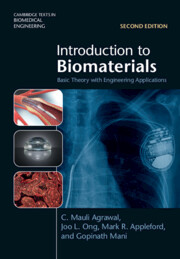Refine search
Actions for selected content:
3388439 results
Preface to the Third Edition
-
- Book:
- Best Practice in Labour and Delivery
- Published online:
- 16 October 2025
- Print publication:
- 06 November 2025, pp xi-xi
-
- Chapter
- Export citation

Seekers and Partisans
- Americans Abroad in the Crisis Years, 1935–1941
- Coming soon
-
- Expected online publication date:
- November 2025
- Print publication:
- 30 November 2025
-
- Book
- Export citation

Introduction to Biomaterials
- Basic Theory with Engineering Applications
- Coming soon
-
- Expected online publication date:
- November 2025
- Print publication:
- 20 November 2025
-
- Textbook
- Export citation
Chapter 29 - Triage and Prioritisation on Labour Wards
-
-
- Book:
- Best Practice in Labour and Delivery
- Published online:
- 16 October 2025
- Print publication:
- 06 November 2025, pp 368-378
-
- Chapter
- Export citation
Chapter 13 - Twin Delivery
-
-
- Book:
- Best Practice in Labour and Delivery
- Published online:
- 16 October 2025
- Print publication:
- 06 November 2025, pp 159-171
-
- Chapter
- Export citation
Contents
-
- Book:
- Kant: Critique of Pure Reason
- Published online:
- 12 September 2025
- Print publication:
- 06 November 2025, pp ix-x
-
- Chapter
- Export citation
Chapter 26 - Rupture of the Uterus
-
-
- Book:
- Best Practice in Labour and Delivery
- Published online:
- 16 October 2025
- Print publication:
- 06 November 2025, pp 331-342
-
- Chapter
- Export citation
Chapter 10 - The Evidence-Based Caesarean Delivery Technique
-
-
- Book:
- Best Practice in Labour and Delivery
- Published online:
- 16 October 2025
- Print publication:
- 06 November 2025, pp 125-136
-
- Chapter
- Export citation
Chapter 16 - Postpartum Haemorrhage
-
-
- Book:
- Best Practice in Labour and Delivery
- Published online:
- 16 October 2025
- Print publication:
- 06 November 2025, pp 195-201
-
- Chapter
- Export citation
Chapter 6 - Identification and Management of Presumed Intrapartum Fetal Distress
-
-
- Book:
- Best Practice in Labour and Delivery
- Published online:
- 16 October 2025
- Print publication:
- 06 November 2025, pp 71-88
-
- Chapter
- Export citation
Chapter 1 - Pelvic and Fetal Cranial Anatomy and the Stages and Mechanism of Labour
-
-
- Book:
- Best Practice in Labour and Delivery
- Published online:
- 16 October 2025
- Print publication:
- 06 November 2025, pp 1-13
-
- Chapter
- Export citation
Immanuel Kant, Critique of Pure Reason
-
- Book:
- Kant: Critique of Pure Reason
- Published online:
- 12 September 2025
- Print publication:
- 06 November 2025, pp 45-668
-
- Chapter
- Export citation

Parallel Computer Organization and Design
- Coming soon
-
- Expected online publication date:
- November 2025
- Print publication:
- 09 October 2025
-
- Textbook
- Export citation
Chapter 15 - Management of the Third Stage of Labour
-
-
- Book:
- Best Practice in Labour and Delivery
- Published online:
- 16 October 2025
- Print publication:
- 06 November 2025, pp 184-194
-
- Chapter
- Export citation
Chapter 14 - Antepartum Haemorrhage
-
-
- Book:
- Best Practice in Labour and Delivery
- Published online:
- 16 October 2025
- Print publication:
- 06 November 2025, pp 172-183
-
- Chapter
- Export citation
Chapter 17 - Management of Placenta Accreta Spectrum
-
-
- Book:
- Best Practice in Labour and Delivery
- Published online:
- 16 October 2025
- Print publication:
- 06 November 2025, pp 202-214
-
- Chapter
- Export citation
Chapter 4 - Intrapartum Fetal Monitoring
-
-
- Book:
- Best Practice in Labour and Delivery
- Published online:
- 16 October 2025
- Print publication:
- 06 November 2025, pp 42-56
-
- Chapter
- Export citation
Chapter 20 - Induction of Labour
-
-
- Book:
- Best Practice in Labour and Delivery
- Published online:
- 16 October 2025
- Print publication:
- 06 November 2025, pp 246-263
-
- Chapter
- Export citation
Chapter 23 - Labour in Women with Medical Disorders
-
-
- Book:
- Best Practice in Labour and Delivery
- Published online:
- 16 October 2025
- Print publication:
- 06 November 2025, pp 285-305
-
- Chapter
- Export citation
Chapter 12 - Umbilical Cord Prolapse
-
-
- Book:
- Best Practice in Labour and Delivery
- Published online:
- 16 October 2025
- Print publication:
- 06 November 2025, pp 149-158
-
- Chapter
- Export citation
